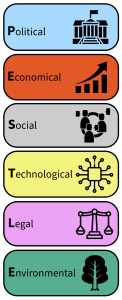7 PESTLE Analysis
Learning Objectives
This chapter discusses the benefits of using the PESTLE framework to help understand the business environment.
PESTLE analysis stands for the following:
- Political Factors
- Economical factors
- Social factors
- Technological factors
- Legal factors
- Environmental factors
PESTLE analysis

PESTLE (Political, Economical, Social, Technological, Legal and Environmental factors) is used as a tool for insight into an industries environment.
Use PESTLE analysis to research how industries and markets operate within their political, legal and economic environments, identify competitors and gaps in the market and to locate accurate and comprehensive financial data.
Being able to successfully research to locate, analyse, use and create information will ensure your business decisions are grounded in reality and improve their chance of success.
PESTLE infographic © Western Sydney University, created by Todd Hillsley is licensed under a CC BY-NC-SA (Attribution NonCommercial ShareAlike) license
Political
Political factors have an impact on industry such as tax policies, trade restrictions, tariffs and immigration policies.
Useful websites may include:
-
Freely available Australian parliamentary documents, including debates (Hansard), media releases, legislation, bills, second readings, explanatory memorandum, senate and house committee transcripts, background papers and research notes. The parliamentary website also includes links to Committee websites and the Parliamentary papers index.[1]
-
Freely available New South Wales parliamentary documents, including debates (Hansard), media releases, legislation, bills, second readings & explanatory memorandum, senate and house committee transcripts, background papers and research papers.[2]
Economic
Economic factors a have direct impact on a company’s long-term prospects in a market. The economic environment may affect how a company prices their products or influence the supply and demand model. Environmental factors can include:
- Inflation rate
- Disposable income
- Unemployment rate
- Interest rates
- Foreign exchange rates
- Economic growth patterns
Databases and websites you may use include:
-
Aggregation of business & economics journals, indexes and abstracts. Includes many full text scholarly journals. Provides company profiles for the world’s 5,000 largest companies.[3]
-
International business/management database. Good for all topics, including industry, economics, accounting & finance, marketing, human resources, organisational behaviour, and coaching psychology.[4]
-
The Treasury is the Australian Government’s website on financial policy and includes economic and fiscal outlook documents, the budget and other information on Australia’s economy.[7]
-
ASIC: Australian Securities and Investment Commission
The Australian Securities and Investment Commission is an independent government body that acts as a corporate regulator. It provides information about companies and organisations and finance news.[8]
-
The Productivity Commission is the Australian Government’s principal review and advisory body on microeconomic policy and regulation. It provides information on current ongoing enquiries, economic news and regulatory reviews.[9]
-
The Organisation for Economic Co-operation and Development is an intergovernmental economic organisation with 36 member countries, founded in 1961 to stimulate economic progress and world trade. The OECD iLibrary provides economic information for all member countries, as well as reports, documents and statistical data.[10]
Social
Social factors, such as demographics and culture can impact the industry environment by influencing peak buying periods, purchasing habits, and lifestyle choices. Society is important as people’s culture and lifestyle can influence when, where and how they are likely to engage with products and services. Social factors can include:
- Religion and ethics
- Consumer buying patterns
- Demographics
- Health
- Opinions and attitudes
- Media
- Brand preferences
- Education
Databases and websites you may use include:
-
The Productivity Commission is the Australian Government’s principal review and advisory body on microeconomic policy and regulation. It provides information on current ongoing enquiries, economic news and regulatory reviews.[13]
-
APA-FT: Australian Public Affairs Full Text via Informit Online (1978 – present)
The place to start for coverage of Australia’s political, economic, social and cultural affairs. Broad-ranging coverage also includes Australian humanities and social sciences, current affairs, and law.[14]
-
ABS – Australian Bureau of Statistics
The Australian Bureau of Statistics website gives access to all of Australia’s census and demographic data, as well as related news releases.[15]
Technological
Technological factors may have a direct or indirect influence on an industry. While some industries will be more affected by technology than others, innovations in technology may affect the market and consumer choices and buying power. Technological factors can include:
- Automation
- Technological development
- Patents
- Licensing
- Communication
- Information technology
- Research and Development
- Technological awareness
To find information on the technological factors in a city or country, investigate the following resources:
-
Australian Bureau of Statistics (ABS)
Contains statistical data from the main demographic, economic and financial publications of the Bureau. Coverage is from 1998 onwards.[16]
-
Aggregation of business & economics journals, indexes and abstracts. Includes many full text scholarly journals. Carries industry reports and academic research in technology-related fields such as ICT and communications.[17]
-
Factiva.com (mid-1980s – present)
Newspapers, company information, pictures and media transcripts from Australian and overseas media sources.[19]
Legal
Legal factors may affect both the internal and external environment of a company. The legal and regulatory environment can affect the policies and procedures of an industry and can control employment, safety and regulations. Legal factors can include:
- Employment laws
- Consumer protection
- Industry-specific regulations
- Regulatory bodies
- Environmental regulations
To find information on the legal factors, investigate the following resources:
-
AGIS Plus Text: Attorney General’s Information Service via Informit Online (1975 – present)
Covering all aspects of Australian law, and an authoritative collection for primary legal research in comparative and Commonwealth law. This includes articles, reports, and books from Australia, New Zealand, and the Asia Pacific region, plus selected material from the United Kingdom, the U.S., and Canada, starting in 1999.[22]
Environmental
Environmental factors include all those relating to the physical environment and general environmental protection requirements. While the environment is more important to some industries, such as tourism, agriculture or food production, these factors may influence a range of different industries and are worth being aware of. Environmental factors include:
- Climate
- Geographical location
- Stakeholder and consumer values
- Environmental offsets
- Weather
- Global climate change
To find information on the environmental factors, investigate the following resources:
-
Environment Complete via Ebsco
Covers all areas of environmental research and technology, environmental law, public policy, social impacts, urban planning, and more. Coverage starts in the 1940s.[24]
-
Web of Science Core Collections
This portal hosts Web of Science, Current Contents Connect, BIOSIS Previews, CAB Abstracts, MEDLINE, and Journal Citation Reports via the Additional Resources tab. Its CrossSearch feature enables a “quick overview” search of these databases and also searches Agricola and Pubmed.[25]
-
Environmental Studies in Video
Contains film covering all realms of environmental studies, particularly ethics, policy, economics, law, sociology, planning, and environmental science.[26]
Chapter Review
- Conduct a PESTLE analysis to understand the external influences on an organisation
- PESTLE stands for Political, Economic, Social, Technological, Legal and Environmental factors
Media Attributions
- PESTLE infographic © Western Sydney University, created by Todd Hillsley is licensed under a CC BY-NC-SA (Attribution NonCommercial ShareAlike) license
- APH, Australian Parliament House, https://www.aph.gov.au/ ↵
- Parliament of New South Wales, Parliament of New South Wales, https://www.parliament.nsw.gov.au/Pages/home.aspx ↵
- EBSCO, Business Source Complete, https://go.openathens.net/redirector/westernsydney.edu.au?url=https%3A%2F%2Fsearch.ebscohost.com%2Flogin.aspx%3Fauthtype%3Dip%2Cuid%26profile%3Dehost%26defaultdb%3Dbth ↵
- ProQuest, ABI/Inform Complete, https://go.openathens.net/redirector/westernsydney.edu.au?url=https://www.proquest.com/abicomplete/fromDatabasesLayer?accountid=36155 ↵
- Euromonitor International, Passport, https://go.openathens.net/redirector/westernsydney.edu.au?url=https://www.portal.euromonitor.com/portal/magazine/homemain ↵
- Australian Government, The Australian Competition and Consumer Commission, https://www.accc.gov.au/ ↵
- Australian Government, The Treasury, https://www.treasury.gov.au/ ↵
- Australian Government, Australian Securities and Investment Commission, https://asic.gov.au/ ↵
- Australian Government, Productivity Commission, https://www.pc.gov.au/ ↵
- OECD, iLibrary, https://www.oecd-ilibrary.org/ ↵
- Dow Jones, Factiva, https://go.openathens.net/redirector/westernsydney.edu.au?url=https://global.factiva.com/en/sess/login.asp?xsid=S003X3pMDFyMT7yMTAtMDQoOTaqMtmm5Ff9R9apRsJpWVFBQUFBQUFBQUFBQUFBQUFBQUFBQUFBQUFBQUFBQUFBQUFB ↵
- WARC, WARC, http://ezproxy.uws.edu.au/login?url=https://www.warc.com/security/login/autologin.aspx ↵
- https://www.pc.gov.au/ ↵
- Informit, Australian Public Affairs - Full Text, https://go.openathens.net/redirector/westernsydney.edu.au?url=https://search.informit.org/topic/rmit-products/ielapa ↵
- Australian Government, Australian Bureau of Statistics, https://www.abs.gov.au/ ↵
- ABS, ABS, https://www.abs.gov.au/ ↵
- EBSCO, Business Source Ultimate, https://go.openathens.net/redirector/westernsydney.edu.au?url=https%3A%2F%2Fsearch.ebscohost.com%2Flogin.aspx%3Fauthtype%3Dip%2Cuid%26profile%3Dehost%26defaultdb%3Dbth ↵
- Elsevier, Scopus, https://go.openathens.net/redirector/westernsydney.edu.au?url=https://www.scopus.com/search/form.uri?display=basic#basic ↵
- Dow Jones, Factiva, https://go.openathens.net/redirector/westernsydney.edu.au?url=https://global.factiva.com/en/sess/login.asp?xsid=S003X3pMDFyMT7yMTAtMDQoOTaqMtmm5Ff9R9apRsJpWVFBQUFBQUFBQUFBQUFBQUFBQUFBQUFBQUFBQUFBQUFBQUFB ↵
- University of Technology Sydney Faculty of Law, Australian Legal Information Institute, http://www.austlii.edu.au/ ↵
- University of Technology Sydney Faculty of Law and University of New South Wales Faculty of Law, World Legal Information Institute, http://www.worldlii.org/ ↵
- Informit, AGIS Plus Text, https://go.openathens.net/redirector/westernsydney.edu.au?url=https://search.informit.org/topic/rmit-products/agispt ↵
- Australian Government, Australian Competition and Consumer Commission, https://www.accc.gov.au/ ↵
- EBSCO, Environment Complete, https://go.openathens.net/redirector/westernsydney.edu.au?url=https://search.ebscohost.com/login.aspx?authtype=ip,uid&profile=ehost&defaultdb=eih ↵
- Clarivate, Web of Science Core Collection, https://go.openathens.net/redirector/westernsydney.edu.au?url=https://www.webofknowledge.com/wos ↵
- Environmental Studies in Video, Environmental Studies in Video, https://go.openathens.net/redirector/westernsydney.edu.au?url=https://search.alexanderstreet.com/envv ↵

